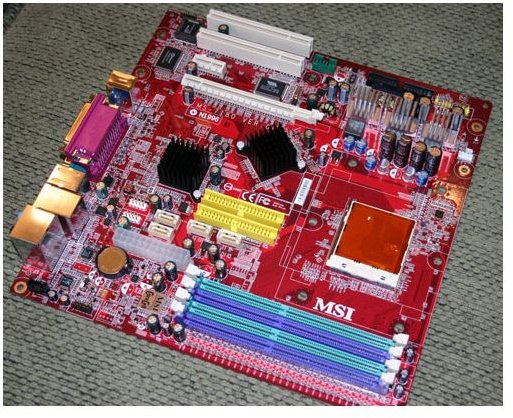AMD BTX Motherboards Examined: Can You Still Buy Them?
BTX’s Origins: Solving the NetBurst Heat Problem
When Intel introduced the Pentium 4 processors and its NetBurst architecture, it ran into a problem. In the late 90s, Intel engineers had reckoned that the best way to go about improving performance was to design a processor architecture that could allow for drastically increased clock speeds. The goal was to reach 10 GHz.
At the time, there were good reasons to reach for this goal, and the best was the difficulity of forcing software to accept threading. The idea of selling processors with multiple cores was on the table, but it was a risky move. Processors with the extra core wouldn’t provide consumers with much performance benefit until the software was updated to take advanatge of the new technology, and that could in some cases take years.
Red-lining clock speeds seemed like the better idea. Clock speeds shot skywards, but so did heat generation. As Intel broke 3 GHz it started to become clear that Pentium 4 processors were generating too much heat, resulting in reduced efficiency. Engineers at Intel now understood that there was a limit to processor clock speeds, but developing a new architecture takes many years. They needed short term solutions, and BTX was one of them.
The Anatomy of BTX
BTX stands for Balanced Technology Extended. Although it’s just one letter different from ATX, it makes some major changes to that standard motherboard form factor.
Traditional ATX motherboards place the processor near the rear. BTX flips that around entirely, placing the processor at the front instead. The RAM is placed at the top of the motherboard and the hard drive ports are placed near the rear I/O panel. Only the PCI expansion cards remain in roughly the same place. The hard drives and power supply are both kept at the bottom/side of BTX compatible cases.
By re-arranging components in this way, the processor was placed directly behind a case’s main air intake, and air then passed across the north-bridge/south-bridge before being exhausted out of the case. This resulted in better cooling efficiency. Cases could be both cooler and smaller than before.
Image Credit: Anandtech
Why BTX Never Took Off
When BTX was first released it was met with praise for its efficiency but also general apathy from enthusiasts. Yes, the format had advantages, but it also required new cases and new power supplies, among other things. Nobody wanted to throw out perfectly good components. In addition to this, the cooling improvements were not absolutely ground-breaking.
Despite this, BTX might have become popular if the problems facing hardware had stayed the same. However, Intel’s release of the Core architecture made it clear that the company was moving away from power-hungry clock speed monsters and towards processors with multiple, more efficient cores. Suddenly, the better airflow of a BTX motherboard was no longer as relevant.
In addition to this, ATX simply adopted some of the advantages given to BTX such as the placement of the power supply and hard drives. And finally, there was AMD - which wasn’t eager to adopt the new form factor.
Did BTX Motherboards for AMD Processors Exist?
The short anwser: Yes, they did. But they are no longer available.

The long anwser: There were indeed some BTX motherboards for AMD processors. The first were released in 2005, but interest for them never picked up. By 2006, the pairing of the acronyms “BTX” and “AMD” was already forgotten, and any BTX motherboards available for Althons were disappearing from the market.
Nothing has changed this situation since. BTX motherboards of any description are now rare. Newegg has 35 listed as compatible with Intel processors, but they’re all out of stock and they all support no Intel socket newer than LGA 775. Finding a motherboard for AMD is virtually impossible. You’ll have to troll eBay in hopes that someone will part out an old computer with such a relic inside.
Even if you do find such a part, it will be too old to support any modern AMD processors. While trying to build a BTX powered computer might be a fun side-project, it’s certainly not a viable way to build a new PC that is intended for day-to-day use.
Image Credit: Anandtech
Alternatives to BTX
Since motherboard formats are not cross-compatible, there’s no true alternative to BTX. If you have a BTX case you generally need a BTX motherboard, and vice versa.
Certain traits of BTX can be replicated, however. If you’re interested in the best cooling efficiency possible, an ATX case with the hard drives and power supply placed at the bottom, away from the motherboard, is a good alternative. Many modern cases offer this as a feature.
Size was another benefit of BTX. The format could generally fit more hardware into a given space. If you’re looking to build a small computer, a Micro-ATX or Mini-ITX motherboard would be your best bet. Our Mini-ITX buying guide should be of assistance.
References
- Bit-Tech: BTX Love Arrives in AMD Camp
- Anandtech: Intel’s Long Awaited BTX Form Factor
- Wikipedia: NetBurst (Microarchitecture)
